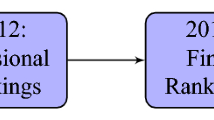Abstract
In many countries, governments grant different capital subsidies to the business sector in order to promote growth. Also the EU, provides this type of subsidies. As De Long and Summers (1991) suggest there may be market failure justifications for public subsidisation of firms. However, because the use of subsidies may cause problems, it is far from clear how they affect long-run economic growth. This study examines the effects on total factor productivity of public capital subsidies to firms in Sweden between 1987 and 1993. Panel data which distinguish between subsidised and unsubsidised firms in the manufacturing industry are used. The results suggest that subsidisation can influence growth, but there seems to be little evidence that the subsidies have affected productivity.
Similar content being viewed by others
References
Baumol, W. J., 1990, ‘Entrepreneurship: Productive, Unproductive, and Destructive’, Journal of Political Economy 98(5), 893–921.
Beason, R. and D. E. Weinstein, 1996, ‘Growth, Economies of Scale, and Targeting in Japan (1955-1990)’, The Review of Economics and Statistics 78(2), May, 286–295.
Begg, I., 1989, ‘European Integration and Regional Policy’, 1989, Oxford Review of Economic Policy 5(2), 90–114.
Bergström, F., 1998a, ‘Do Capital Subsidies to Firms Increase Employment?’, Chapter 9 in G. Eliasson and N. Karlson (eds.), The Limits of Government: On Policy Competence and Economic Growth, City University Press, Stockholm.
Bergström, F., 1998b, ‘Regional Policy and Convergence of Real per Capita Income among Swedish Counties’, Working Paper No. 284, Stockholm School of Economics.
Blomström, M., R. E. Lipsey and M. Zejan, 1996, ‘Is Fixed Investment the Key to Economic Growth?’, The Quarterly Journal of Economics. 111, February, 267–276.
Brezis, E. S., P. Krugman and D. Tsiddon, 1993, ‘Leapfrogging in International Competition: A Theory of Cycles in National Technological Leadership’, The American Economic Review 83(5), 1211–1219.
Burton, J., 1983, Picking Losers...?, The Institute of Economic Affairs, London.
Caves, R. E. and D. R. Barton, 1990, Efficiency in U.S. Manufacturing Industries, The MIT Press, Cambridge, Massachusetts.
Dahmén, E., 1998, ‘Technology, Technique and Entrepreneurial Activity in Economic Theory: An historical outline’, in J. Odhnoff and U. Svedin (eds.), Technological Systemic Changes and Economic Theories
De Long, J. B. and L. H. Summers, 1991, ‘Equipment Investment and Economic growth’, The Quarterly Journal of Economics 106, May, 445–502.
EU, 1996, Europeiska unionens stöd och lån – Vägledning till gemenskapens finansiering, Byrån för Europeiska gemenskapernas officiella publikationer, Bryssel, 1996.
Kornai, J., 1986, ‘The Soft Budget Constraint’, Kyklos 39(1), 3–30.
Lee, J.-W., 1996, ‘Government Interventions and Productivity Growth’, Journal of Economic Growth 1, September, 391–414.
Leibenstein, H., 1966, ‘Allocative Efficiency vs. "XEfficiency"’, The American Economic Review 56(3), 392–415.
Lundberg, E., 1961, Produktivitet och räntabilitet. Studier i kapitalets betydelse inom svenskt näringsliv, Norstedt, Stockholm, Sweden.
Maddala, G. S., 1989, Introduction to Econometrics, Maxwell Macmillan Int. Editions, New York.
Maddison, A., 1982, Phases of Capitalist Development, Oxford University Press, Oxford.
Mitchell, W. C. and M. C. Munger, 1991, ‘Economic Models of Interest Groups: An Introductory Survey’, American Journal of Political Science 35(2), May, 512–546.
Nickell, S. J., 1996, ‘Competition and Corporate Performance’, Journal of Political Economy 104(4), 724–746.
NUTEK, 1993, Värdet av regionalpolitiken, Report R:43, Stockholm.
OECD, 1993, Industrial Policy in OECD Countries – Annual Review, OECD.
OECD, 1996, Public Support to Industry, OECD/GD(96)82.
Ohlin, G., 1962,’ Review of Lundberg (1961)’, American Economic Review 52, September, 827–829.
Olson, M., 1982, The Rise and Decline of Nations: Economic Growth, Stagflation, and Social Rigidities, Yale University Press, New Haven.
Persson, J., 1997, ‘Convergence Across the Swedish Counties, 1911–1993’, European Economic Review 41, 1835–1852.
Sala-i-Martin, X. X., 1996, ‘Regional Cohesion: Evidence and Theories of Regional Growth and Convergence’, European Economic Review 40, 1325–1352.
Schmidt, K. M., 1991, ‘Managerial Incentives and Product Market Competition’, CEPR, Discussion paper series, No. 1382.
SOU, 1996, Kompetens och kapital – Om statligt stöd till företag, Betänkande från Företagsstödutredningen, SOU 1996: 69, Stockholm.
Tsoukalis, L., 1993, ‘Regional Policies and Redistribution’, Ch. 19 in R. T. Griffiths (ed.), The Economic Development of the EEC, An Elgar Reference Collection. Cheltenham. U.K.
White, H., 1980, ‘A Heteroskedasticity-Consistent Covariance Matrix and a Direct Test for Heteroskedasticity’, Econometrica 48.
Wolff, E. N., 1996, ‘The Productivity Slowdown: The Culprit at Last? Follow-up on Hulten and Wolff’, The American Economic Review 86(5), December, 1239–1252.
Author information
Authors and Affiliations
Rights and permissions
About this article
Cite this article
Bergström, F. Capital Subsidies and the Performance of Firms. Small Business Economics 14, 183–193 (2000). https://doi.org/10.1023/A:1008133217594
Issue Date:
DOI: https://doi.org/10.1023/A:1008133217594




